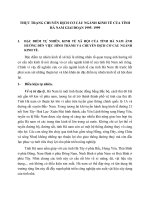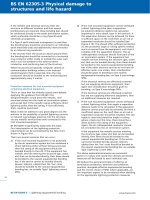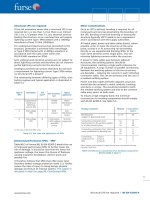Bsi bs en 02489 1995 (1999)
Bạn đang xem bản rút gọn của tài liệu. Xem và tải ngay bản đầy đủ của tài liệu tại đây (350.16 KB, 12 trang )
BRITISH STANDARD AEROSPACE SERIES
Fibre reinforced
plastics —
Determination of the
action of test fluids
The European Standard EN 2489:1995 has the status of a
British Standard
UDC 678.067:621.193.19:629.7
ICS 49.040.10
BS EN
2489:1995
BS EN 2489:1995
Committees responsible for this
British Standard
The preparation of this British Standard was entrusted to Technical
Committee ACE/64, upon which the following bodies were represented:
British Plastics Federation
Ministry of Defence
Society of British Aerospace Companies Limited
This British Standard, having
been prepared under the
direction of the Engineering
Sector Board, was published
under the authority of the
Standards Board and
comes into effect on
15 December 1995
© BSI 12-1999
The following BSI references
relate to the work on this
standard:
Committee reference ACE/64
Draft for comment 88/78341 DC
ISBN 0 580 23108 9
Amendments issued since publication
Amd. No.
Date
Comments
BS EN 2489:1995
Contents
Committees responsible
National foreword
Foreword
Text of EN 2489
National annex NA (informative) Committees responsible
National annex NB (informative) Cross-references
© BSI 12-1999
Page
Inside front cover
ii
2
3
Inside back cover
Inside back cover
i
BS EN 2489:1995
National foreword
This British Standard has been prepared by Technical Committee ACE/64 and is
the English language version of EN 2489:1995 Aerospace series — Fibre
reinforced plastics — Determination of the action of test fluids, published by the
European Committee for Standardization (CEN).
EN 2489 was produced as a result of international discussions in which the
United Kingdom took an active part.
Cross-reference
Publication referred to
Corresponding British Standard
EN 2744:1992
BS EN 2744 Non-metallic materials. Preferred test
temperatures
A British Standard does not purport to include all the necessary provisions of a
contract. Users of British Standards are responsible for their correct application.
Compliance with a British Standard does not of itself confer immunity
from legal obligations.
Summary of pages
This document comprises a front cover, an inside front cover, pages i and ii,
the EN title page, pages 2 to 6, an inside back cover and a back cover.
This standard has been updated (see copyright date) and may have had
amendments incorporated. This will be indicated in the amendment table on the
inside front cover.
ii
© BSI 12-1999
EUROPEAN STANDARD
EN 2489
NORME EUROPÉENNE
September 1995
EUROPÄISCHE NORM
ICS 49.040.10
Descriptors: Aircraft industry, plastics, reinforced plastics, glass reinforced plastics, chemical tests, chemical resistance, chemical
compounds, liquids
English version
Aerospace series — Fibre reinforced plastics —
Determination of the action of test fluids
Série aérospatiale — Plastiques renforcés de
fibres — Détermination de l’action des fluides
d’essais
Luft- und Raumfahrt — Faserverstärkte
Kunststoffe — Bestimmung des Einflusses von
Prüfflüssigkeiten
This European Standard was approved by CEN on 1995-09-19. CEN members
are bound to comply with the CEN/CENELEC Internal Regulations which
stipulate the conditions for giving this European Standard the status of a
national standard without any alteration.
Up-to-date lists and bibliographical references concerning such national
standards may be obtained on application to the Central Secretariat or to any
CEN member.
This European Standard exists in three official versions (English, French,
German). A version in any other language made by translation under the
responsibility of a CEN member into its own language and notified to the
Central Secretariat has the same status as the official versions.
CEN members are the national standards bodies of Austria, Belgium,
Denmark, Finland, France, Germany, Greece, Iceland, Ireland, Italy,
Luxembourg, Netherlands, Norway, Portugal, Spain, Sweden, Switzerland and
United Kingdom.
CEN
European Committee for Standardization
Comité Européen de Normalisation
Europäisches Komitee für Normung
Central Secretariat: rue de Stassart 36, B-1050 Brussels
© 1995 Copyright reserved to CEN members
Ref. No. 2489:1995 E
EN 2489:1995
Foreword
Contents
This European Standard has been prepared by the
European Association of Aerospace Manufacturers
(AECMA).
After inquiries and votes carried out in accordance
with the rules of this Association, this Standard has
successively received the approval of the National
Associations and the Official Services of the member
countries of AECMA, prior to its presentation to
CEN.
According to the Common CEN/CENELEC Rules,
the following countries are bound to implement this
European Standard: Austria, Belgium, Denmark,
Finland, France, Germany, Greece, Iceland,
Ireland, Italy, Luxembourg, Netherlands, Norway,
Portugal, Spain, Sweden, Switzerland and
United Kingdom.
Foreword
1 Scope
2 Normative references
3 Principle
4 Test fluids
5 Apparatus
6 Specimens
7 Procedure
8 Expression of results
9 Designation
10 Test report
Table 1
2
Page
2
3
3
3
3
3
3
4
5
6
6
4
© BSI 12-1999
EN 2489:1995
1 Scope
This standard specifies the method of immersion of fibre reinforced plastics in test fluids.
It does not give any directives to meet health and safety requirements. It is the responsibility of the user
of this standard to adopt appropriate health and safety precautions.
2 Normative references
This European Standard incorporates by dated or undated reference provisions from other publications.
These normative references are cited at the appropriate places in the text and the publications are listed
hereafter. For dated references, subsequent amendments to or revisions of any of these publications apply
to this European Standard only when incorporated in it by amendment or revision. For undated references
the latest edition of the publication referred to applies.
EN 2379, Aerospace series — Test fluids for non-metallic materials1).
EN 2743, Aerospace series — Reinforced plastics — Standard procedures for conditioning prior to testing1).
EN 2744, Aerospace series — Non-metallic materials — Preferred test temperatures.
3 Principle
Determine:
— changes in appearance after immersion, or after immersion and drying;
— changes in mechanical and physical characteristics immediately after immersion, or after immersion
and drying.
Specimens in fibre reinforced plastics are subjected to a total immersion in the specified fluid for a specified
period and temperature.
The characteristics are determined before and after immersion and possibly after elimination of the fluid
by drying.
4 Test fluids
4.1 As detailed in the material standard unless otherwise specified.
NOTE 1
EN 2379 shall be used as a basis.
4.2 In case of a fluid of unknown or variable composition, it is important that all samples of fluids are taken
from the same container.
NOTE 2
This recommendation is valid only within the same series or programme of tests.
5 Apparatus
5.1 Glass beakers of a size suited to the dimensions of the specimens.
5.2 Temperature controlled vessel capable of maintaining the beakers at the immersion temperature
accurate to ± 2 °C
5.3 Vapour condensation system, if required
5.4 Thermometer of appropriate scale and accuracy
5.5 Ventilated drying oven which can be maintained at the specified temperature accurate to ± 2 °C
5.6 Sealable container (e.g. desiccator)
5.7 Balance accurate to within 0,1 mg
5.8 Magnifying glass with magnification of 10 times
6 Specimens
A comparison between different fibre reinforced plastics using this method is only possible if the test
specimens have the same shape, dimensions and condition (surface finish, etc.).
6.1 Cut at least five specimens from the laminate for each temperature and period of immersion and record
their original position within the laminate.
1) Published
as AECMA Prestandard at the date of publication of this standard
© BSI 12-1999
3
EN 2489:1995
If the tests alter the test specimens (in particular, destructive testing), an additional series of test
specimens is required in order to act as a reference.
6.2 For the shape, dimensions and fabrication method of the specimens see the test standard concerned.
If several test specimen sizes are specified, by preference the thickness closest to 3 mm for glass fibre2)
reinforced laminates and to 2 mm for carbon fibre2) reinforced laminates shall be selected.
7 Procedure
7.1 Immersion temperatures
If it is not specified in the material standard, choose in preference one of the following temperatures:
— (23 ± 2) °C;
— (70 ± 2) °C;
— (100 ± 2) °C.
If another temperature is needed, select it from EN 2744 with a tolerance of ± 2 °C.
Check that the temperature chosen is not too close to the glass transition temperature of the laminate.
7.2 Duration of the immersion
If it is not specified in the material standard, choose in preference one of the following periods of immersion:
— 24 h for a short test;
— 4 weeks for a normal test;
— 26 weeks for a long test.
The immersion time can, if required, be selected from Table 1.
Table 1
Hours
1
2
4
8
16
AA
AB
AC AD AE
Weeks
24
48
96
168 2
AF
AG AH AJ
4
BA BB
8
16
BD BE
Years
26
52
1,5
2
BF
BG CA CB
3
4
5
CC
CD CE
Designation codes
7.3 Immersion (for each specimen)
— Unless otherwise specified, immersion shall be carried out in the dark.
— Use at least 4 ml of fluid per square centimeter of the total specimen surface area.
— Immerse the specimen completely. When the specimens are composed of the same material, several
may be placed in the same beaker, provided they do not touch each other.
— Ensure that contact between specimens and beaker walls and specimen supports is point contact so
as to ensure that as much as possible of the specimen is wetted.
— Cover the beakers and place them in the temperature controlled vessel.
— Stir the fluid at least once per day and readjust its level, if necessary.
— Replace the fluid periodically in order to ensure that its composition is maintained.
NOTE
It may be necessary to check the fluid after immersion. This check may be a simple visual examination or an analysis.
7.4 Removal of the fluid
Unless otherwise specified, it shall be removed by one of the following methods:
— wiping;
— rinsing then wiping;
— drying (if applicable).
7.4.1 Rinsing and wiping
At the end of the period of immersion, the temperature of the specimens may be brought to ambient
temperature or to the test temperature by transferring them rapidly into a new quantity of fluid at the
specified test temperature. An immersion period of 15 min to 30 min shall be allowed before testing.
2) For
4
other fibres, complementary information will be introduced, if necessary, later.
© BSI 12-1999
EN 2489:1995
Remove the specimens from the fluid. If necessary, rinse them with a product which does not affect the
material and which is compatible with the fluid then wipe them with filter paper or lint-free cloth.
7.4.2 Drying
After immersion in a volatile fluid, dry in an oven at (70 ± 2) °C until constant mass is obtained, cool in a
sealed container.
7.5 Determination of the characteristics after immersion
7.5.1 Ambient temperature test (23 ± 2) °C
Carry out the test within the 15 min which follow the removal from the sealed container.
7.5.2 Test at other than ambient temperature
Place each specimen in the test fixture which is held at the specified temperature.
Maintain the specimen at the specified test temperature for a period which is:
— either specified in the material standard;
— or determined during preliminary tests. For these tests, use an identical specimen which has been
subjected to the same conditions of immersion and exposure to the same temperature on the same
fixture. Check that the exposure time is sufficient so that all points on the specimen achieve the specified
temperature without an unacceptable loss of the absorbed fluid.
8 Expression of results
8.1 Visual aspect
Examine each specimen after immersion, with the magnifying glass if necessary, while comparing it with
a specimen that has not been immersed. Note the observed changes according to the following
characteristics:
— colour (type and uniformity);
— opacity for translucent laminates;
— gloss of the surface;
Record also if the following defects are present:
— splits and cracks;
— blisters, pitting or other similar defects;
— degraded materials removed easily by rubbing;
— tackiness;
— delamination, warping or other distortion.
Scale of severity: none, low, medium, high.
8.2 Physical and mechanical properties
The action of fluids on the physical and mechanical properties of the material shall be expressed in one of
the three following ways:
— percentage change;
— residual percentage;
— change.
8.2.1 Percentage change (%)
8.2.1.1 After immersion
R2 – R1
-------------------- × 100
R1
8.2.1.2 After immersion and drying
R3 R1
-------------------- ì 100
R1
â BSI 12-1999
5
EN 2489:1995
where:
— R1 is the mean of the results before immersion;
— R2 is the mean of the results after immersion;
— R3 is the mean of the results after immersion and drying.
8.2.2 Residual percentage (%)
8.2.2.1 After immersion
R
------2- × 100
R1
8.2.2.2 After immersion and drying
R
------3- × 100
R1
8.2.3 Change
8.2.3.1 After immersion
R2 – R1
8.2.3.2 After immersion and drying
R3 – R1
9 Designation
EXAMPLE:
10 Test report
It shall contain the following:
— number of this standard,
— complete identification of the material or tested product (traceability);
— type of specimens used, method of their preparation, dimensions, surface finish, etc.,
— location of the test specimens within the laminate;
— identification of the fluid used, immersion temperature and time;
— frequency of the additions or renewals of the fluid;
— temperatures and duration of drying (if necessary);
— test report of the tests performed;
— exposure time at the test temperature (if required);
— changes in visual aspect;
— calculated changes (see 8.2);
— results of examination of the fluid, when carded out;
— any incident which may have affected the results.
6
© BSI 12-1999
BS EN 2489:1995
National annex NA (informative)
Committees responsible
The United Kingdom participation in the preparation of this European Standard was entrusted by the
Aerospace Standards Policy Committee (ACE/-) to Technical Committee ACE/64, upon which the following
bodies were represented:
British Plastics Federation
Ministry of Defence
Society of British Aerospace Companies Limited
National annex NB (informative)
Cross-references
The British Standards corresponding to the European Standards referred to in the text are identical in
number and title with these given in clause 2 with the exception of EN 2379 and EN 2743 for which no
corresponding British Standards exist.
© BSI 12-1999
BS EN
2489:1995
BSI — British Standards Institution
BSI is the independent national body responsible for preparing
British Standards. It presents the UK view on standards in Europe and at the
international level. It is incorporated by Royal Charter.
Revisions
British Standards are updated by amendment or revision. Users of
British Standards should make sure that they possess the latest amendments or
editions.
It is the constant aim of BSI to improve the quality of our products and services.
We would be grateful if anyone finding an inaccuracy or ambiguity while using
this British Standard would inform the Secretary of the technical committee
responsible, the identity of which can be found on the inside front cover.
Tel: 020 8996 9000. Fax: 020 8996 7400.
BSI offers members an individual updating service called PLUS which ensures
that subscribers automatically receive the latest editions of standards.
Buying standards
Orders for all BSI, international and foreign standards publications should be
addressed to Customer Services. Tel: 020 8996 9001. Fax: 020 8996 7001.
In response to orders for international standards, it is BSI policy to supply the
BSI implementation of those that have been published as British Standards,
unless otherwise requested.
Information on standards
BSI provides a wide range of information on national, European and
international standards through its Library and its Technical Help to Exporters
Service. Various BSI electronic information services are also available which give
details on all its products and services. Contact the Information Centre.
Tel: 020 8996 7111. Fax: 020 8996 7048.
Subscribing members of BSI are kept up to date with standards developments
and receive substantial discounts on the purchase price of standards. For details
of these and other benefits contact Membership Administration.
Tel: 020 8996 7002. Fax: 020 8996 7001.
Copyright
Copyright subsists in all BSI publications. BSI also holds the copyright, in the
UK, of the publications of the international standardization bodies. Except as
permitted under the Copyright, Designs and Patents Act 1988 no extract may be
reproduced, stored in a retrieval system or transmitted in any form or by any
means – electronic, photocopying, recording or otherwise – without prior written
permission from BSI.
This does not preclude the free use, in the course of implementing the standard,
of necessary details such as symbols, and size, type or grade designations. If these
details are to be used for any other purpose than implementation then the prior
written permission of BSI must be obtained.
BSI
389 Chiswick High Road
London
W4 4AL
If permission is granted, the terms may include royalty payments or a licensing
agreement. Details and advice can be obtained from the Copyright Manager.
Tel: 020 8996 7070.









